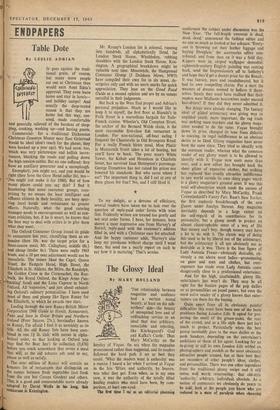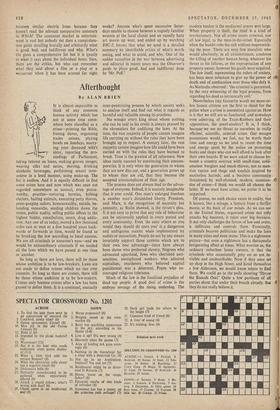The Glossy Ideal
By MARY HOLLAND s, tainers are there for the buying.
The first time I sat at an editorial planning conference the subject under discussion was the New Year. The full-length overcoat is dead, dead. dead,' announced the fashion editor and no one so much as looked at her askance. 'Every- one is throwing out their leather luggage and buying fibreglass,' the accessories editor con- tributed; and from then on it was a field day. Kippers were in, striped wallpaper demoded; eighteenth-century English painting was coming back, send the Impressionists off to Sotheby's and hope they'd get a decent price for the Renoir. It was fantasy, pure and unadulterated, but it had its own compelling charm. For a start the weavers of dreams seemed to believe it them- selves. Surely they must have realised that their readers were Midlands housewives under massed hair-driers? If they did they never admitted it.
But things were already changing. The fantasy ideal of gilded aristocracy •was giving way to ungilded youth; more important, the rag trade was seeking mass markets and the glossy maga- zines needed to do the same. Vogue brought down its price, changed its tone from didactic to coaxing, its regal indifference to an obvious desire to be liked. Glossy magazines have never been the same since. They tried to identify with the common reader, whereas what the common reader of any glossy wants is to be allowed to identify with it. Vogue now costs more than ever, and a new editor has brought back the sheer glitter of expensive clothes, but nothing has replaced that cruelly attractive indifference to any world outside its own shiny pages which is a glossy magazine's greatest asset. It was this total self-absorption which made the success of Vogue as described by Mary McCarthy, Frank Crowninshield's Vanity Fair, Ross's New Yorker, the first euphoric breakthrough of the new Queen under Jocelyn Stevens. Any magazine inevitably depends to a large extent on the self-regard of its contributors for its personality, but a glc-vvsy needs to project an almost claustrophobic sense of a way of life that money can't buy, though money may have a lot to do with it. The classic way of doing this used to be by liberal use of the aristocracy, but the aristocracy is all too obviously not as desirable as it was. There is the lone figure of Lady Antonia Fraser—obviously desirable, ob- viously a cut above most ladies—pronouncing on guns and men and clothes, but over- exposure has made even Lady Antonia come dangerously close to a professional entertainer.
And for the high, unattainable, glossy life, entertainers just won't do. They may be all right for the feature pages of the pop dailies or as personalities on panel games, but even the most naive reader of a glossy knows that enter-
Quite apart from all its obviously painful difficulties this must have been one of the basic problems facing London Life. It opted for pro- jecting the smell of the grease-paint, the roar of the crowd, and as a life style there just isn't much to project. Particularly when the best gossip inevitably goes to the mass dailies or the posh Sundays, depending on the entertainer's ambitions or those of his agent. Looking for an in-group to call its own London Life settled on photographers and models as the most obviously attractive people around, but at their best they are recorders of other people's ideas, clothes, and personalities. There was one other ingredient from the traditional glossy recipe and it still seems well worth resurrecting: that old-style 'authority,' arbitrary, individual, absolute. As a nation of consumers we obviously do yearn to be told: look at the people you know who are reduced to a slate of paralysis when choosing
between similar electric irons because they haven't read the relevant comparative summary in Which? The consumer market in entertain- ment is vast but nobody yet does a comprehen- sive guide detailing brutally and arbitrarily what is good, bad, and indifferent and why. What's On gives a comprehensive list but it is treacly in what it says about the individual items. Sure, there are the critics, but who can remember what they said about a film or a play or a oestaurant when it has been around for eight weeks? Anyone who's spent successive Satur- days unable to choose between a vaguely familiar western at the local classic and an equally hazy art movie up west, and ended up by watching BBC-3, knows that what we need is a detailed summary by identifiable critics of what's worth seeing, and what to avoid, and why. One of the sadder casualties in the war between advertising and editorial in recent years was the Observer's guide to plays good, bad and indifferent done by `Mr. Puff.'































 Previous page
Previous page